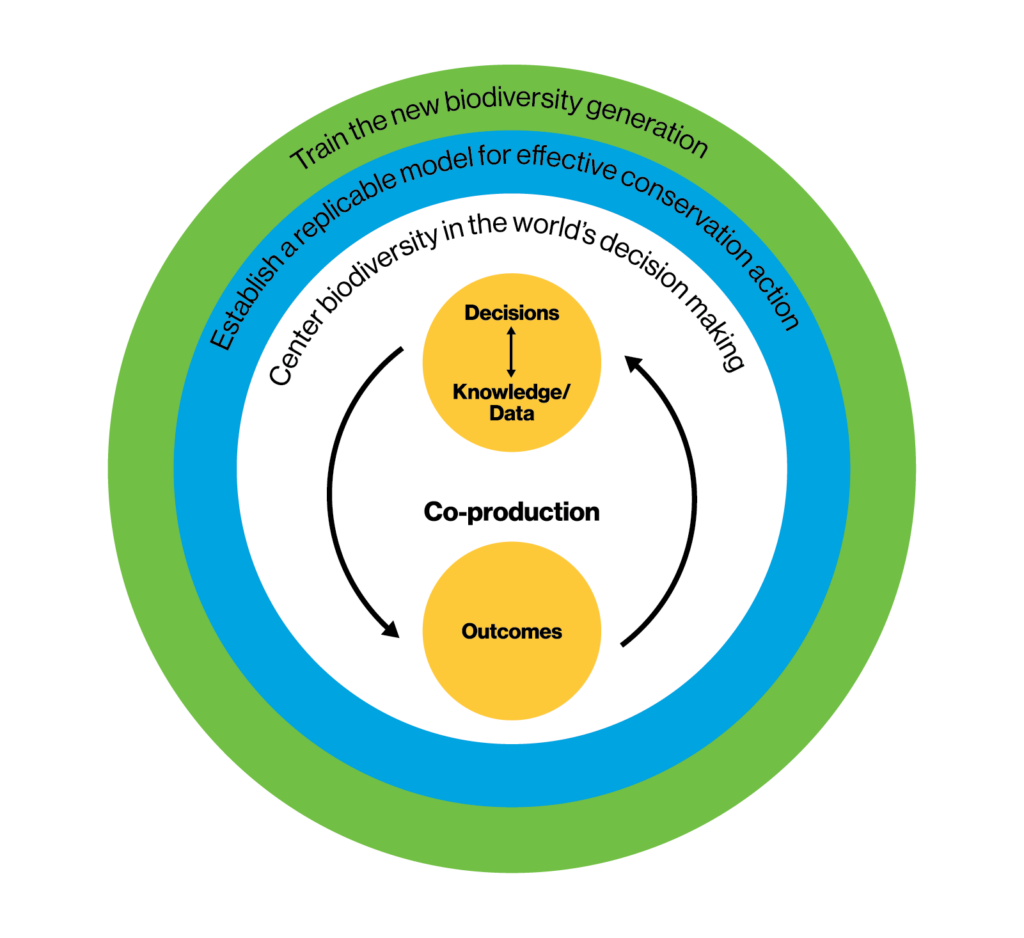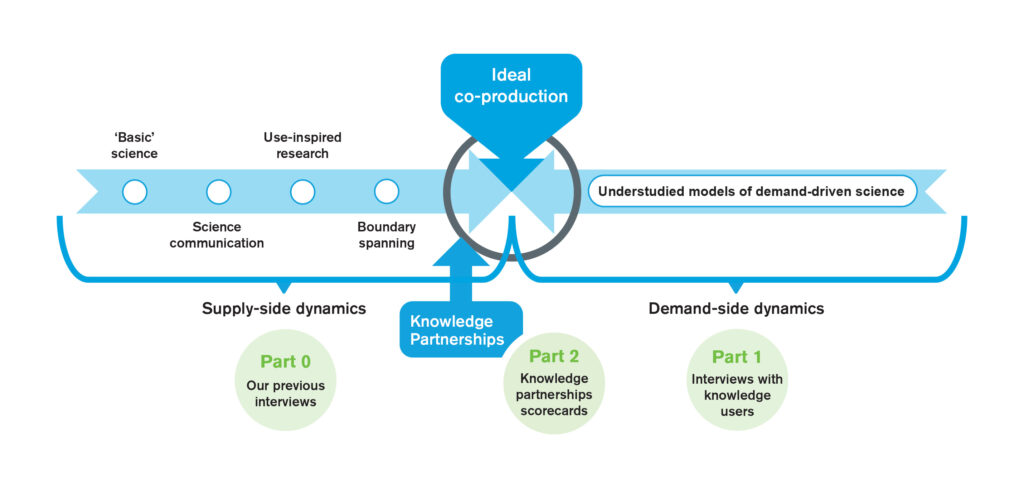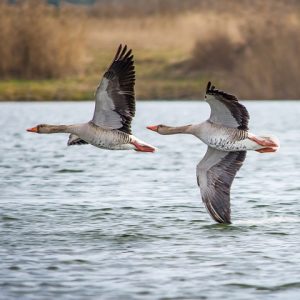Summary
In an effort to move the discipline of conservation science forward, we have dedicated many years to developing actionable, boundary-spanning, and co-designed research. Our goal is to better link the production and use of knowledge in conservation, overcoming the “loading dock” problem. While there has been exponential growth in conservation research, much of this work fails to inform practice and policy.
Globally, there is an increasing emphasis on developing solutions at scale for conserving natural ecosystems and the processes that human communities depend on. This project aims to provide public value to conservation science, ensuring that conservation research is driven by the knowledge needs of practitioners, and that those practitioners have access to the knowledge they need to make informed and effective decisions.
The Actionable Science in Conservation project originated as a collaborative effort between the ASU Center for Biodiversity Outcomes and the Center for Organizational Research and Design.

Our Research
Background
In recent years, conservation researchers (knowledge producers) have recognized that partnerships with stakeholders (knowledge users) are essential for realizing measurable conservation outcomes. These partnerships, referred to here as knowledge-action-partnerships or KAPs, represent a model for both research and action that can advance public value outcomes. This project studies the role of knowledge partnerships in linking the supply of and demand for conservation knowledge. In particular, we ask:
- What are the mechanisms by which the demand for knowledge informs the production and supply of science in the field of conservation?
- What are the mechanisms by which knowledge which is produced by researchers is used to inform practice in the field of conservation?
- What role do knowledge partnerships play in linking the supply of and demand for conservation knowledge, and what effect does the design of these partnerships have on their ability to deliver public value?
- How can research projects and knowledge partnerships be designed to serve the needs of both knowledge producers and knowledge users, avoid public value failures, improve the connection between the production and use of science, and thus increase the public value of scientific activity?
By analyzing the experiences of knowledge producers and knowledge users, and by exploring the possibilities inherent in knowledge partnerships as a distinct organizational form, we aim to understand the organizational configurations best suited for facilitating both demand-driven conservation research and research-informed conservation decision-making. Our work identifying the indicators of public value success is directly relevant to many governmental, private, and non-profit organizations, including those working on conservation and those focused in other areas. We believe conservation research can be broadened to involve many different sources of knowledge, to involve knowledge users more closely, to improve the connection between the production and use of science, and therefore to increase the public value of scientific activity. This research provides guidelines on how to design knowledge partnerships for public value and will offer new models of institutional partnerships to address complex social and ecological aspects of biodiversity conservation, thus enabling solutions that are relevant, culturally sensitive, economically viable and nimble.
Knowledge Partnerships
We use the term knowledge partnerships (KP) to describe the institutional arrangements under which knowledge producers and users jointly participate in the production and application of knowledge. KP may be unofficial collaborations between individuals, official collaboration between organizations, or anything in-between. They are the organizational contexts within which supply and demand are linked, where knowledge and action inform each other in order to produce public value. Effective partnerships have been identified as an important feature of co-production (Vincent et al.,2020) and of demand-driven science models such as citizen science (Soleri et al., 2016), as well as an essential component of traditional (supply-driven) models of linking knowledge to action such as technology transfer (Bozeman, 2000) and university-industry collaborations (Ankrah & AL-Tabbaa, 2015; Rybnicek & Königsgruber, 2019). Although both supply-driven and demand-driven models involve partnerships, these can take diverse forms. For example, the fraught relationship between scientists and citizens during Flint, Michigan’s water crisis (Carrera et al., 2019) is significantly different from the bureaucratic partnerships that stem from technology transfer between universities and industry (Grimaldi et al., 2011). There remains much to be studied regarding the organizational forms KPs might take, and how they may be designed to enhance public value.
Public Value Theory
Conservation scientists acknowledge the importance of partnering with stakeholders in business, government, and non-governmental organizations to manage biodiversity. By identifying individual behaviors and institutional designs that increase the public value outcomes from these partnerships, which represent a form of knowledge transfer that advances scientific contributions to society, this research advances understanding of how publicly supported science can be directed to optimize public benefits and social significance and builds a foundation for advancing public value outcomes in other fields of science. We translate research into practice through connections with the practitioner communities and by sharing findings on effective partnership strategies.
Public value theory is a conceptual framework that has been examined empirically in science and technology cases. Much of this research has focused on developing typologies of public value failures and characterizing instances according to these typologies. This project extends this line of research by recognizing public value outcomes in biodiversity research as a product of both individual behaviors and institutional arrangements, moving towards establishing a causal basis for public value outcomes in a single, specific domain of scientific research. Using field study methods including semi-structured interviews, this project examines the behaviors and attitudes of biodiversity researchers relative to scientific productivity, and how networks of researchers, including those from universities, government, and think tanks work together in affecting different types of scientific outcomes.
Knowledge Co-production
Co-production of knowledge happens within a partnership between two different groups: the knowledge suppliers and the knowledge users. Co-production is a process of knowledge production that necessarily involves equal participation by those from both groups (Miller & Wyborn, 2018). We imagine co-production as a meeting point of two vectors, representing knowledge users and knowledge producers. Knowledge producers may be located anywhere along their vector, from the end farthest away from the co-production intersection to the intersection itself, representing their ‘proximity’ to knowledge users. At the far left end sit isolated ivory tower researchers, motivated by the ‘free play of free intellects’ concept and maximally disengaged from the knowledge users. Between that extreme and the co-production terminal are many other concepts which inform and motivate knowledge production, such as science communication, actionable science, stakeholder engagement, use-inspired research and boundary spanning. These could be organized along the vector with regards to how closely they engage with users. The vector represents the guiding ideas and actions of knowledge suppliers and therefore represents the possible spectrum of supply-driven science.

The right side of the ideal co-production figure represents the guiding ideas and actions of knowledge users. This vector is independent of the other vector but the two interact near the point of intersection, linking in the practice of co-production; it represents the range of concepts and actions which guide how knowledge users seek out science. Concepts identified in the literature—such as citizen science (Kimura & Kinchy, 2016)—involve interacting with knowledge producers and are close to the terminal. Little is known within the scientific community regarding what ideas and actions guide the far end of the vector because these actions generally do not involve researchers.
Much work has been done considering how to bring knowledge producers closer to the intersection of the two vectors and into collaborative co-production (Beier et al., 2016; Gerber et al., 2020; Mach et al., 2020; Van Kerkhoff & Lebel, 2015), but it remains unclear what processes and forces bring knowledge users to the table. Our previous research focus has been on the study of supply-side knowledge production, but demand-side dynamics must be considered as well if coproduction is to be understood. As such, we now work to examine demand-side dynamics and situations where knowledge needs are (or are not) met.
Tools
The Knowledge-Action Partnership Scorecard (KAPS) is designed to facilitate the establishment and management of partnerships between a university and other organizations (other universities, industry, NGOs, etc). It serves three strategic and interrelated functions: partnership guidance, partnership health, and partnership learning.
The scorecard is most appropriate for assessing partnerships between a small number of organizations, typically just two. Responses to the survey are converted to numerical scores to facilitate discussions between partners to identify and address areas of opportunity. While the questions are geared to assessing more formal partnerships, newer and/or more informal partnerships can receive valuable insights especially while individuals are still in the process of figuring out future directions. The tool is most insightful if individuals from both partner organizations complete the assessment.
To assess your partnership and identify possible ways to strengthen it, fill out the KAP Scorecard linked here. Once you have filled out the scorecard, download and follow the instructions provided in the Partnership Scoring Worksheet to get an overall partnership score based on responses and scores for each phase of the partnership (Initiation, Operation, and Delivery) and each thematic category (Organizational factors, Team factors, and Goals/Outcomes). You can also read through the questions in the form to help you design a new partnership to ensure it’s set up for success.
If you are interested in using the tool for research purposes, please reach out to Dr. Chris Barton for more details.

Publications and Presentations
Academic publications
- Gerber, L.R., and Raik, D. (2018). Conservation science needs new institutional models for achieving outcomes. Frontiers in Ecology and the Environment, 16(8), 438–439. https://doi.org/10.1002/fee.1951
- Gerber, L.R., Barton, C.J., Cheng, S.H., and Anderson, D. (2020). Producing actionable science in conservation: Best practices for organizations and individuals. Conservation Science and Practice, 2(12). https://doi.org/10.1111/csp2.295.
- Barton, C.J., Wang, Q., Anderson, D.M., and Callow, D.A. (2021). Synchronizing the Logic of Inquiry with the Logic of Action: The Case of Urban Climate Policy. Sustainability, 13(19), 10625. https://doi.org/10.3390/su131910625.
- Carr Kelman, C., Barton, C.J., Whitman, K., Lhoest, S., Anderson, D.M., and Gerber, L.R. (2022). Five approaches to producing actionable science in conservation. Conservation Biology, 37(2). https://doi.org/10.1111/cobi.14039.
- Gerber, L.R., Barton, C.J., and Anderson, D.M. (2023). Aligning the logics of inquiry and action to address the biodiversity crisis. Conservation Biology, 37(5). https://doi.org/10.1111/cobi.14128.
- Barton, C.J., Anderson, D.M., Gerber, L.R., Carr Kelman, C., and Arízaga, M. (2024). A scorecard for designing and evaluating university partnerships. In From Purpose to Impact (pp. 238–264). Routledge eBooks. https://doi.org/10.4324/9781003459217-23
- Lhoest, S., Carr Kelman, C.; Barton, C.J.; Beaudette, J. and Gerber, L.R. (2024). The impact factor of engaged research: Metrics for conservation outcomes. Biological Conservation 292: 110534. https://doi.org/10.1016/j.biocon.2024.110534
- Carr Kelman, C., Srinivasan, J.; Lorenzo Bajaj, T.; Raschke, A.B.; Brown-Wood, R.N.; Kellner, E.; Ahn, M.; Kariuki, R.W.; Simeone, M.; and Schoon, M. (2024). Convergence research as transdisciplinary knowledge coproduction within cases of effective collaborative governance of social-ecological systems. Ecology and Society 29(4):23. https://doi.org/10.5751/ES-15534-290423
- Gerber L.R., Iacona G.D. (2024). Aligning data with decisions to address the biodiversity crisis. PLoS Biology 22(6): e3002683. https://doi.org/10.1371/journal.pbio.300268.
- Barton, C.J., Grossman, G.M., & Hafed, Y. (2025). Operationalizing the pluriverse: Tools for a new paradigm in global development. Oxford Development Studies. https://doi.org/10.1080/13600818.2025.2494023
- Gerber, L.R; Barton, C.J; Beaudette, J; Behravesh, SA; Cramer, K; Drummond-Otten, C; Goebel, J; Hall, S; Iacona, G; Kroetz, K; Mitchell, A; Nelson, M; Polidoro, B. (under review). Toward a culture of interdependence in conservation science. Conservation Biology.
Other publications
- Lhoest, S., Carr Kelman, C., Barton, C., Beaudette, J., & Gerber, L. (2024, May 13). Reforming academia to maximise conservation impacts. Current Conservation. https://www.currentconservation.org/reforming-academia-to-maximise-conservation-impacts/
- Carr Kelman, C., Lhoest, S., Barton, C., Beaudette, J., & Gerber, L. (2024, July 4). Universities must do more to help researchers help society – Research Professional News. Research Professional News. https://www.researchprofessionalnews.com/rr-news-europe-views-of-europe-2024-7-universities-must-do-more-to-help-researchers-help-society/
Presentations
- Understanding pathways of knowledge to action in conservation. Dr. Leah Gerber presented this talk as part of her fellowship with the Oxford Martin School.
- Levels of Engagement: A typology of approaches to producing actionable conservation science. Presented by Dr. Candice Carr Kelman at the Integrative Conservation Conference.
- Industry partnerships for biodiversity outcomes: Measuring private sector contributions toward mitigating biodiversity loss. Dr. Leah Gerber hosted this panel discussion.
- Knowledge to outcomes in global biodiversity conservation. Dr. Leah Gerber delivered this virtual talk as part of the New Mexico State University’s Climate Change Education Seminar Series.
- Assessing conservation partnerships as spaces for knowledge coproduction. Presented by PhD student Rebecca Snyder at the Conservation Social Science Conference.
- Biodiversity and Profitability: Mapping the natural environment’s influence on your firm’s profitability. Presented by Dr. Leah Gerber and Chris Barton as a microsession at Trellis’s GreenBiz conference.
Funding
- National Science Foundation – Science of Science and Innovation Policy (Award #1661406)
- National Science Foundation – Science of Science – Discovery, Communication, Impact (Award #2122157)
- National Science Foundation – Science of Science – Discovery, Communication, Impact (Award #2420896)